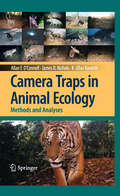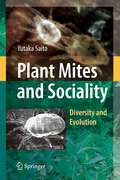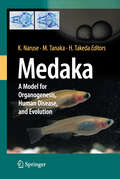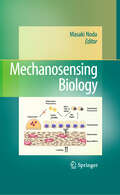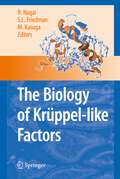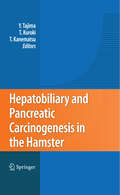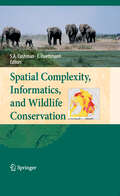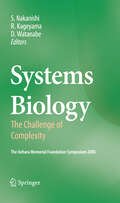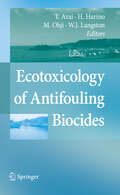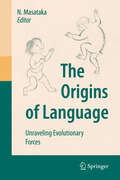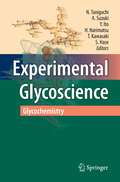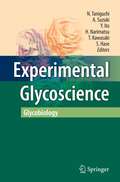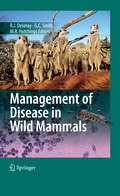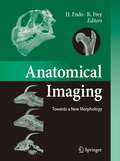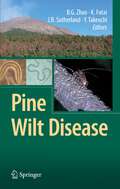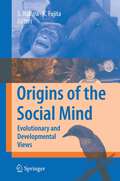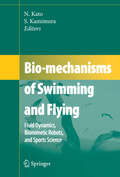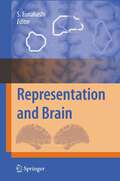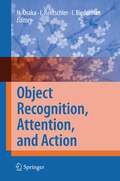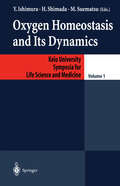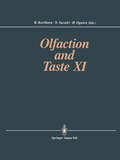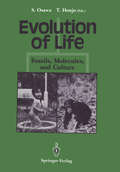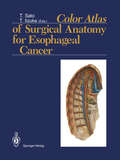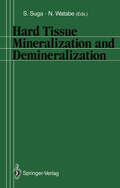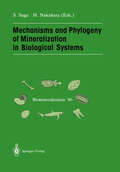- Table View
- List View
Camera Traps in Animal Ecology: Methods and Analyses
by Allan F. O’Connell, James D. Nichols and K. Ullas KaranthRemote photography and infrared sensors are widely used in the sampling of wildlife populations worldwide, especially for cryptic or elusive species. Guiding the practitioner through the entire process of using camera traps, this book is the first to compile state-of-the-art sampling techniques for the purpose of conducting high-quality science or effective management. Chapters on the evaluation of equipment, field sampling designs, and data analysis methods provide a coherent framework for making inferences about the abundance, species richness, and occupancy of sampled animals. The volume introduces new models that will revolutionize use of camera data to estimate population density, such as the newly developed spatial capture–recapture models. It also includes richly detailed case studies of camera trap work on some of the world’s most charismatic, elusive, and endangered wildlife species. Indispensible to wildlife conservationists, ecologists, biologists, and conservation agencies around the world, the text provides a thorough review of the subject as well as a forecast for the use of remote photography in natural resource conservation over the next few decades.
Plant Mites and Sociality: Diversity and Evolution
by Yutaka SaitoMites are very small animals, characterized by wingless and eyeless bodies, in which sociality has been discovered. This book offers detailed descriptions of the diverse social systems and the social evolution of mites, ranging from genetic to ecological aspects. Through a broad spectrum of studies including traditional natural history, taxonomy, modern evolutionary and behavioral ecology, and theoretical models as well, the book addresses a number of important findings on plant mite evolution and species radiation, with the author succeeding in combining theoretical and practical approaches in behavioral ecology by proposing a new game theory. These findings reflect the complex evolutionary history of these taxa and also help to point out clearly what is known and what is not yet known to date. Mites have been considered a minor animal group, but the author shows that mites actually possess great diversity and therefore make unique materials for evolutionary and behavioral studies.
Medaka: A Model for Organogenesis, Human Disease, and Evolution
by Kiyoshi Naruse, Minoru Tanaka and Hiroyuki TakedaOryzias latipes, known as medaka, is a model organism from East Asia. Breeding of this small, egg-laying freshwater teleost fish has long been popular among hobbyists in Japan. Now, as biological science has entered the genome era, the medaka provides significant advantages that make it one of the most valuable vertebrate models: a large collection of spontaneous mutants collected over a century, the presence of highly polymorphic inbred lines established over decades, and a recently completed genome sequence. This book is the first comprehensive monograph to cover a variety of medaka research. It opens with a historical view of medaka, followed by a series of research topics in the four major areas where the medaka is increasingly important: genomics, genetics, and resources; organogenesis and disease models; germ cells, sex determination, and reproduction; and evolution. Readers will find state-of-the-art information on medaka genetics and genomics such as the first isolation of active transposons in vertebrates, the influence of chromatin structure on sequence variation, fine QTL analysis, and versatile mutants as human disease models.
Mechanosensing Biology
by Masaki NodaMechanical stress is vital to the functioning of the body, especially for tissues such as bone, muscle, heart, and vessels. It is well known that astronauts and bedridden patients suffer muscle and bone loss from lack of use. Even the heart, in pumping blood, causes mechanical stress to itself and to vascular tissue. With the loss of mechanical stress, homeostasis becomes impaired and leads to pathological conditions such as osteopenia, muscle atrophy, and vascular tissue dysfunction. In elderly populations, such mechanical pathophysiology, as well as the mechanical activities of locomotor and cardiovascular systems, is important because skeletal and heart functions decline and cause diseases in other organs. In this monograph, mechanical stress is discussed by experts in the field with respect to molecular, cellular, and tissue aspects in relation to medicine. Covering topics such as gravity and tissues and disuse osteoporosis, the book provides the most up-to-date information on cutting-edge advancements in the field of mechanobiology and is a timely contribution to research into locomotor and circulatory diseases that are major problems in contemporary society.
The Biology of Krüppel-like Factors
by Ryozo Nagai Scott L. Friedman Masato KasugaKruppel-like factors (KLFs) are attracting great attention across a wide spectrum of biological sciences and medicine because of their remarkable biological potency and the diversity of roles they play in the physiological and pathological changes of cells and tissues. This book is a comprehensive compendium of the latest research on the molecular mechanisms of KLFs, describing their roles in transcriptional regulation, cellular differentiation and development, the pathogenesis of the liver and cardiovascular systems and cancer, and generation of ES cells and iPS cells. As the only concise treatise written to date by leading experts in the field, it serves as an authoritative review of this family of molecules and is an essential reference for all who are interested in KLFs. The book also explores the potential of KLFs as targets for novel therapeutics and diagnostics, and will be invaluable in those fields.
Hepatobiliary and Pancreatic Carcinogenesis in the Hamster
by Yoshitsugu Tajima Tamotsu Kuroki Takashi KanematsuMalignant neoplasms occurring in the biliary tract and pancreas remain a therap- tic challenge. The mechanism of carcinogenesis as well as the growth and spread of these tumors is still poorly understood, making the development of rational tre- ment strategies difficult. In order to improve the clinical results achieved by sur- cal or other medical treatment of such malignant tumors, the establishment of an experimental animal model is critical. For this purpose, attempts were made to induce carcinoma experimentally in the biliary tree and finally an animal model using the hamster was established in 1994 at our laboratory. Because the tumor in this model mimicked the characteristics of human tumors, a series of experimental investigations were conducted to clarify the pathological characteristics of biliary carcinoma, the genetic alterations during biliary carcinogenesis, and the relationship between biliary inflammation and c- cinogenesis. The chemopreventive effects on the occurrence of biliary carcinoma were also successfully examined. In addition, in vitro studies led to the establi- ment of transplantable biliary cancer cell lines and biliary epithelial cell lines by utilizing the hamster model. This monograph represents the collective efforts in hepato-biliary and pancreatic disease research over the past 20 years. I hope that this monograph will be a source of useful knowledge for basic researchers as well as for clinicians involved in the care of patients with hepato-biliary and pancreatic neoplasms. Takashi Kanematsu, M.D., Ph.D.
Spatial Complexity, Informatics, and Wildlife Conservation
by Samuel A. Cushman Falk HuettmannAs Earth faces the greatest mass extinction in 65 million years, the present is a moment of tremendous foment and emergence in ecological science. With leaps in advances in ecological research and the technical tools available, scientists face the critical task of challenging policymakers and the public to recognize the urgency of our global crisis. This book focuses directly on the interplay between theory, data, and analytical methodology in the rapidly evolving fields of animal ecology, conservation, and management. The mixture of topics of particular current relevance includes landscape ecology, remote sensing, spatial modeling, geostatistics, genomics, and ecological informatics. The greatest interest to the practicing scientist and graduate student will be the synthesis and integration of these topics to provide a composite view of the emerging field of spatial ecological informatics and its applications in research and management.
Systems Biology: The Challenge of Complexity
by Shigetada Nakanishi Ryoichiro Kageyama Dai WatanabeBiological signaling pathways dynamically interact with one another to form complex information networks intracellularly, intercellularly, and eventually at the level of the organism. Biology and medicine have conventionally focused on identification and characterization of functional elements in biological signaling pathways. Recently, research in this field has pursued a new approach, systems biology, to understand the dynamics, complexity, and physiological functions of the biological signaling networks. Instead of reductionistic analyses or large-scale studies of biomolecules piece by piece, systems biology emphasizes the need for interdisciplinary methods and analysis of the regulation and operation of information networks at the systems level. The contributors to this book are leading researchers in the rising field of systems biology. Readers will find not only the most recent advances in research, but also the latest information about interdisciplinary methods and related topics.
Ecotoxicology of Antifouling Biocides
by Takaomi Arai Hiroya Harino Madoka Ohji William LangstonOrganotin compounds, used as antifouling biocides since 1960, are chemical compounds that act as endocrine disrupters. It is not known how organotin compounds cause hormone disturbance, however, and many questions remain about their effect on aquatic organisms. Studies on organotin compounds have recently evolved, with many new findings reported. Following a worldwide ban on organotin compounds in 2008, alternative compounds will mainly be used, with the potential for coastal areas to become contaminated, causing, among other effects, cholinesterase inhibition in aquatic organisms. Use of alternative compounds must be controlled to avoid such errors. These and other findings are described and concisely summarized in this book, providing a useful reference in countries where alternative biocides are being considered. Included are studies on the effects on marine organisms, making this book an excellent aid to experts in environmental chemistry, to government organizations, and to students.
The Origins of Language: Unraveling Evolutionary Forces
by Nobuo MasatakaDevelopments in cognitive science indicate that human and nonhuman primates share a range of behavioral and physiological characteristics that speak to the issue of language origins. This volume has three major themes, woven throughout the chapters. First, it is argued that scientists in animal behavior and anthropology need to move beyond theoretical debate to a more empirically focused and comparative approach to language. Second, those empirical and comparative methods are described, revealing underpinnings of language, some of which are shared by humans and other primates and others of which are unique to humans. New insights are discussed, and several hypotheses emerge concerning the evolutionary forces that led to the "design" of language. Third, evolutionary challenges that led to adaptive changes in communication over time are considered with an eye toward understanding various constraints that channeled the process.
Experimental Glycoscience: Glycochemistry
by Hisashi Narimatsu Toshisuke Kawasaki Sumihiro Hase Naoyuki Taniguchi Akemi Suzuki Yukishige ItoThe aim of this book is to provide experimental protocols covering many aspects of glycobiology, glycotechnology, and chemistry: biochemistry, molecular and cellular biology, genetics, physiology, and medicine. The protocols are all self-contained descriptions of the equipment and reagents needed, followed by details of the experimental procedure. In the post-genomic era, glycobiology is coming of age because more than half of proteins are glycosylated and the importance of sugar chains in various fields of life science research cannot be disregarded. Many scientists had not entered this area because glycobiology and glycoscience used to be considered difficult fields. This book, therefore, is presented much like a cookbook which can help scientists in fields other than glycobiology and glycoscience carry out research more easily.
Experimental Glycoscience: Glycobiology
by Hisashi Narimatsu Toshisuke Kawasaki Sumihiro Hase Naoyuki Taniguchi Akemi Suzuki Yukishige ItoThe aim of this book is to provide experimental protocols covering many aspects of glycobiology, glycotechnology, and chemistry: biochemistry, molecular and cellular biology, genetics, physiology, and medicine. The protocols are all self-contained descriptions of the equipment and reagents needed, followed by details of the experimental procedure. In the post-genomic era, glycobiology is coming of age because more than half of proteins are glycosylated and the importance of sugar chains in various fields of life science research cannot be disregarded. Many scientists had not entered this area because glycobiology and glycoscience used to be considered difficult fields. This book, therefore, is presented much like a cookbook which can help scientists in fields other than glycobiology and glycoscience carry out research more easily.
Management of Disease in Wild Mammals
by Richard Delahay Graham C. Smith Michael R. HutchingsIn recent years nobody could have failed to notice the frequent and often sensati- alist media headlines warning of the latest global disease threat to humankind. But behind all the hyperbole lie real challenges related to dealing with the increasing incidence of emerging zoonotic disease events, the majority of which are thought to originate in wildlife (Jones et al. 2008). There are also many important diseases of domestic livestock which also occur in wildlife (e. g. foot and mouth disease and classical swine fever in wild boar, bovine tuberculosis in deer, badgers or possums), some of which can have a devastating impact on the farming industry, the wider rural economy and ultimately the public purse. But we should also not forget that wildlife diseases may have serious implications for the conservation of biodiversity. For some of the rarest, most endangered species (such as the Ethiopian wolf) d- ease may pose the greatest threat to their survival. If we are to avoid or reduce these impacts then we must improve our ability to detect and manage the risks associated with disease in wildlife populations. This is a challenge that will require expertise from many different disciplines: veterinary, ecological, medical, economic, poli- cal and zoological. In such an interdisciplinary field it is difficult to stay up to date with contemporary ideas and with techniques that may be rapidly evolving.
Anatomical Imaging: Towards a New Morphology
by Hideki Endo Roland FreyThis book presents selected works of contemporary evolutionary morphologists and includes such topics as broad scale reconstructions of the brain and ear of dinosaurs, inference of locomotor habits from cancellous bone architecture in fossil primates, and a comparison of the independently evolved manipulating apparatuses in the lesser and giant pandas. Insight is provided into the application of modern noninvasive technologies, including digital imaging techniques and virtual 3D reconstruction, to the investigation of complex anatomical features and coherences. In combination with traditional methods, this allows for the formulation of improved hypotheses on coordinated function and evolution. The creation of virtual translucent specimens makes it possible to realize the age-old dream of the classical anatomists: looking through the skin into the inner organization of an organism. On full display here is the dramatic and promising impact that modern imaging techniques have on scientific progress in evolutionary morphology.
Pine Wilt Disease
by Bo Guang Zhao Kazuyoshi Futai Jack R. Sutherland Yuko TakeuchiPine forests face a global threat of pine wilt disease, which is being spread by vector beetles carrying pathogenic nematodes from dead trees to healthy ones. Among the host pines there are varying degrees of susceptibility, and nematode strains also contain a variety of virulences, both of which factors help to determine whether infected host trees will die or survive. As well, biotic and abiotic environmental factors influence the fate of infected trees. This book describes the history of the disease, pathogenic nematodes, vector beetles, the etiology and ecology of the disease, microorganisms involved, and control methods that utilize host resistance and biological control agents. Concrete, comprehensive, and the most up-to-date knowledge about this worldwide forest epidemic is presented for readers, enabling them to understand the nature and epidemic threat of pine wilt disease.
Origins of the Social Mind: Evolutionary and Developmental Views
by Shoji Itakura Kazuo FujitaIncludes social cognition in birds and nonhuman primates as well as various aspects of social cognition in human children
Bio-mechanisms of Swimming and Flying: Fluid Dynamics, Biomimetic Robots, and Sports Science
by Naomi Kato Shinji KamimuraThis book covers a wide range of animals from flagellated microorganisms to marine mammals. It follows "Bio-mechanisms of Animals in Swimming and Flying" published in 2004 including 11 chapters. This time, the book includes 31 chapters on the latest researches into natural autonomous systems and locomotion in both flying and swimming organisms. The area of sports science such as analysis and simulation of human swimming is newly added. The computational frameworks for the modeling, simulation and optimization of animals in swimming and flying demonstrate an important role in the progress of interdisciplinary work in the fields of biology and engineering.
Representation and Brain
by Shintaro FunahashiUnderstanding brain functions, especially the neural mechanisms of higher cognitive processes such as thinking, reasoning, judging, and decision making, are the subjects covered by the chapters of this book. They describe recent progress in four major research areas: visual functions, motor functions, memory functions, and prefrontal functions. There are many color illustrations making this book an especially valuable resource for students and researchers in neuroscience.
Object Recognition, Attention, and Action
by Naoyuki Osaka Ingo Rentschler Irving BiedermanHuman object recognition is a classical topic both for philosophy and for the natural sciences. Ultimately, understanding of object recognition will be promoted by the cooperation of behavioral research, neurophysiology, and computation. This original book provides an excellent introduction to the issues that are involved. It contains chapters that address the ways in which humans and machines attend to, recognize, and act toward objects in the visual environment.
Oxygen Homeostasis and Its Dynamics (Keio University International Symposia for Life Sciences and Medicine #1)
by MakotoSuematsu HideoShimada YuzuruIshimuraThis first volume in a projected series contains the proceedings of the first of the Keio University International Symposia for Life Sciences and Medicine under the sponsorship of the Keio University Medical Science Fund. As stated in the address by the President of Keio University at the opening of the 1996 symposium, the fund of Dr. Mitsunada Sakaguchi. The Keio was established by the generous donation University International Symposia for Life Sciences and Medicine constitute one of the core activities of the fund. The objective is to contribute to the international community by developing human resources, promoting scientific knowledge, and encouraging mutual exchange. Every year, the Executive Committee of the Interna tional Symposia for Life Sciences and Medicine selects the most interesting topics for the symposium from applications received in response to a call for papers to the Keio medical community. The publication of these proceedings is intended to publicize and distribute information arising from the lively discussions of the most exciting and current issues during the symposium. Weare grateful to Dr. Mitsunada Sakaguchi, who made the symposium possible, the members of the program committee, and the office staff whose support guaran teed the success of the symposium. Finally, we thank Springer-Verlag, Tokyo, for their assistance in publishing this work. Akimichi Kaneko, M. D. , Ph. D.
Olfaction and Taste XI: Proceedings of the 11th International Symposium on Olfaction and Taste and of the 27th Japanese Symposium on Taste and Smell Joint Meeting held at Kosei-nenkin Kaikan, Sapporo, Japan, July 12–16, 1993
by Kenzo Kurihara Noriyo Suzuki Hisashi OgawaIn this compendium of current studies on olfaction and taste - the most comprehensive yet to appear in this series - the chemical senses are elucidated from points of view ranging from anatomy, electrophysiology, molecular biology (especially chemoreceptor gene cloning), biochemistry, and psychophysics to the latest clinical and technological applications of chemosensory research. Specific topics include the structure and function of the tastebud and olfactory epithelium; the genetics and mechanisms of olfactory and taste transduction; the chemistry and function of flavor compounds; the psychophysics of taste and olfaction in daily human life; the brain mechanisms of coding, learning, and memory in olfaction and taste; the clinical assessment of taste and olfaction with special reference to aging and disorders; noninvasive measurements of human olfactory and taste responses for therapeutic purposes; artifical sensing devices; chemoreception in aquatic organisms and other species; and chemosensory transduction in insects. With its multidisciplinary approach, this volume will be an invaluable source of information not only for researchers, clinicians, and students but also for technologists in fields such as artificial sensing, perfumery, brewery, food chemistry, aquafarming, and agriculture.
Evolution of Life: Fossils, Molecules and Culture
by Syozo Osawa Tasuku HonjoNearly thirty million species of organisms are believed to now live on Earth. In addition to accumulating evidence from classical biology, paleontology and earth science, the recent progress of molecular biology has provided new insights into understanding how present-day organisms have evolved with such tremendous diversity. Molecular biological studies show us that all living forms, including E. coli and human beings, derive from a single ancestor that emerged some 4 billion years ago on Earth. This volume aims to discuss the motifs of organismic evolution from the viewpoints of biogeo-interactions and diversification of the genetic systems. Based on these fundamental understandings, the last section of this volume is devoted to human evolution that includes phylogeny of man as well as evolution of human culture. Such comprehensive discussion will give us a synthesized view of the evolution of life, that is undoubtedly one of the most important problems not only for science but also for human culture in general.
Color Atlas of Surgical Anatomy for Esophageal Cancer
by Tatsuo Sato and Toshifumi IizukaIt is essential to know all of the intricate lymph pathways when performing surgery for esophageal cancer in order to determine the extent of lymph node metastasis. Professor Sato has undertaken, at the request of the TNM Research Committee of the International Society for Diseases of the Esophagus, to map out and classify the lymph nodes of the mediastinum and neck. The beautiful artwork in the Color Atlas of Surgical Anatomy for Esophageal Cancer edited by Professor Sato gives an excellent understanding of the lymph node pathways and their importance in surgical treatment. Minute dissections which represent real life situations, not just the superficial pathways, show the precise location and topographical arrangement of the lymphatics. Full-color schematics are given with the actual dissection illustrations and photographs. The atlas clearly presents the classification of four significant pathways and their communication, the relationship of these pathways en route to the venous angles and the definition and assessment of the most critical nodes. Thoracic surgeons especially will benefit from the excellent illustrations of surgical techniques and the methods for recording the dissected lymph nodes which are presented by Professor Kakegawa. Leading experts fighting esophageal cancer with surgical treatment can use the classification in this outstanding atlas for many years to come as a standard for international comparison. The careful dissection of the lymph nodes may be the best way to improve survival rates after surgery for cancer of the thoracic esophagus.
Hard Tissue Mineralization and Demineralization
by Norimitsu Watabe Shoichi SugaComparative investigations of mineralization and demineralization mechanisms by leading researchers give a general perspective on this interdisciplinary field of the life sciences and an introduction to current research methods and concepts. The studies are concentrated in the areas of calcium phosphate mineral formation in vertebrate bone and teeth and calcium carbonate mineral formation in coral skeletons and molluscan shells.
Mechanisms and Phylogeny of Mineralization in Biological Systems: Biomineralization ’90
by Shoichi Suga Hiroshi NakaharaVarious kinds of mineralization have been found in many biological systems. Investigations made at a microscopical level using various sophisticated analytical methods and using principles developed in different fields have clarified their mechanisms very much. Sometimes, very similar phenomena have been found in the mineralized tissues of completely different biological systems. Compilation and comparative investigations of such findings obtained from the many specimens systematically collected contribute a great deal to an understanding of the crucial mechanisms and significance of biominerali zation which originated in very primitive organisms and remain in advanced ones. Previously, the functional significance of mineralized tissues was considered mainly from an anatomical point of view based upon their morphological and structural features. However, the recent advance of investigations has made it possible to interpret the func tional significance of biomineralization not only from local and mechanical points of view, but also from a systemic and phylogenetic point of view. It is also well-known that biomineralization has contributed in various ways to geological and oceanographical conditions of the environment in which the organisms were living. During this process, the mechanisms of biomineralization may have evolved to maintain harmony between organisms and their environments.
